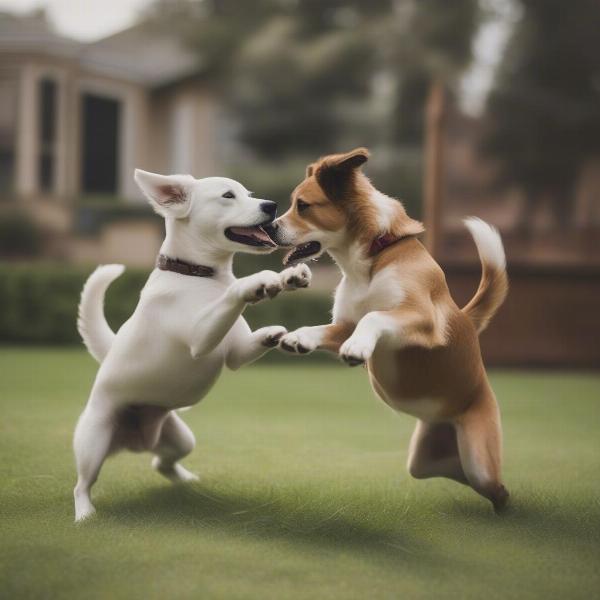Reconciling dogs, or introducing two or more dogs to each other with the goal of peaceful cohabitation, can be a delicate process. Whether you’re bringing a new puppy home to an older dog, or merging two established dog households, a slow and careful approach is key to fostering positive relationships and avoiding conflict. This guide will provide you with a comprehensive understanding of how to reconcile dogs successfully, covering everything from initial introductions to ongoing management strategies.
First Impressions Matter: Initial Introductions
The first meeting between dogs sets the tone for their future relationship. Choose a neutral location, such as a park or a friend’s yard, where neither dog feels territorial. Keep both dogs on leashes, allowing them to approach each other gradually while maintaining a safe distance. Observe their body language closely. Loose, wagging tails and playful bows are positive signs. Stiffness, staring, raised hackles, or growling indicate discomfort or potential aggression. If you see any negative signals, separate the dogs immediately and try again later, perhaps with the help of a professional dog trainer.
Building a Positive Association: Parallel Walks
Once the initial introduction goes smoothly, parallel walks can be a great way to build a positive association between the dogs. Walk the dogs side-by-side, keeping a comfortable distance between them. This allows them to become accustomed to each other’s presence and scent without direct interaction. Gradually decrease the distance between them as they become more comfortable.
Sharing Space: Gradual Integration at Home
Introducing the dogs in the home should be a gradual process. Initially, keep the dogs separated in different rooms, allowing them to acclimate to each other’s scent through the closed door. Swap their bedding or toys to further familiarize them with each other’s smells. Short, supervised visits can then be introduced, gradually increasing the duration as the dogs become more comfortable. Provide separate food bowls, water dishes, and resting areas to minimize competition.
Managing Resources: Avoiding Conflict Over Food and Toys
Resource guarding is a common cause of conflict between dogs. Feed the dogs in separate areas and supervise them closely during mealtimes. Pick up toys when the dogs are not playing with them to prevent possessive behavior. If one dog shows signs of resource guarding, consult with a professional dog trainer or behaviorist for guidance. reconcile dogs
Long-Term Harmony: Ongoing Management and Observation
Even after the dogs have seemingly reconciled, ongoing management and observation are essential. Supervise their interactions, especially during playtime and when new people or animals are present. Be aware of subtle shifts in body language that may indicate underlying tension. dog schleich animals Continue to provide each dog with their own space and resources to minimize competition. With patience, consistency, and a proactive approach, you can help your dogs develop a harmonious and lasting relationship.
 Two Dogs Playing Together Peacefully
Two Dogs Playing Together Peacefully
Conclusion
Reconciling dogs takes time, patience, and understanding. By following these guidelines and paying close attention to your dogs’ individual needs and personalities, you can create a positive and enriching environment for all members of your furry family. Remember, a successful introduction is not about forcing the dogs to become best friends, but rather about helping them coexist peacefully and respectfully. schleich dogs
FAQ
-
How long does it take to reconcile dogs? There is no set timeframe. It can take days, weeks, or even months depending on the dogs’ individual personalities and histories.
-
What if my dogs fight during the introduction process? Separate them immediately and reassess your approach. You may need to seek professional help from a dog trainer or behaviorist.
-
Can I leave my dogs alone together unsupervised once they seem to be getting along? It’s best to supervise them closely, especially during the initial stages of integration. Gradually increase the time they spend together unsupervised as they become more comfortable.
-
Is it easier to reconcile dogs of opposite sexes? Not necessarily. While some believe opposite-sex pairings are easier, it ultimately depends on the individual dogs’ personalities.
-
What if one of my dogs is significantly older than the other? Take extra care when introducing an older dog to a puppy. Puppies can be very energetic and may overwhelm an older dog. dog anxiety medication uk
-
Should I punish my dogs if they growl at each other? No, growling is a form of communication. Punishing a dog for growling may suppress the warning signs and lead to a bite.
-
What are some signs that my dogs are successfully reconciled? Signs of a positive relationship include relaxed body language, playing together appropriately, sharing space comfortably, and showing no signs of aggression or tension. fluoxetine for dogs price
About ILM Dog: ILM Dog is your trusted international resource for expert advice on dog care and wellbeing. We offer practical guidance on a wide range of topics, from breed selection and puppy care to senior dog health and behavioral training. We’re committed to providing dog owners with the knowledge and support they need to build strong, lasting bonds with their canine companions. Contact us at [email protected] or +44 20-3965-8624 for personalized advice and discover more resources at https://ilmdog.com.